
Updated 28 July 2016

|
Updated 28 July 2016 |
|
HOME PAGES GLOBAL WARMING WHAT YOU CAN DO GREEN ISSUES BACKGROUND THE INITIATIVE |
Choosing an Efficient Car This page presents advice on choosing a car that emits less greenhouse gas, and also saves money as fuel and other motoring costs increase. After an overview of the main points, we give more details on choosing between current petrol, diesel, hybrid and electric models. Government subsidies for electric cars and plug-in hybrids are described. We also comment on diesel car pollution. At the end there is a short section on how annual road tax has changed, first to favour greener cars, but soon less so. On other pages we compare different means of transport, give tips for saving fuel whatever you are driving, and discuss the possibilities for alternative road fuels (e.g. biofuels) and hydrogen and fuel cells. Overview For most households in Blewbury a car is essential. People living in a town or city are often able to do without a car by using public transport, bicycles and walking. However, it’s more difficult for people living in a village like Blewbury, with limited bus service and few shops and services within walking distance. Cycling, walking and improved bus services can play a role for some journeys, and many households with two or more cars might well be able to manage with one. But for most of us, convenient access to cars will almost certainly be needed for the foreseeable future. The decision to buy or replace a car is likely to be made for reasons other than the effects on the environment. However, when making a choice of what to buy you should also consider environmental issues. In this section we summarise these. 
Should I keep my old car as long as possible? If you do a high mileage, it would be beneficial to sell your relatively inefficient car to someone who will do a low mileage, and then buy a more efficient second-hand car. If you scrap an old, inefficient car and purchase a new car things are more complicated. If you do a low mileage, and the new car is not significantly more efficient, there is a strong environmental argument for waiting. However, if the new car is much more efficient – as many of them are – or if the old car may be expensive to repair, the decision becomes less clear and depends on the circumstances. It has been estimated that the CO2 cost of manufacturing a new car and scrapping the old one is perhaps around 10% of the total emissions during the lifetime of the vehicle. How useful are the official fuel consumption and emission figures? The official figures for all cars being sold must be provided on manufacturers’ websites and advertising. However, for a more comprehensive listing, including searches for specific models, go to carfueldata.direct.gov.uk – but remember that these consumption figures are achieved under artificial conditions and in practice it is very unlikely that you will match them, as mentioned below. 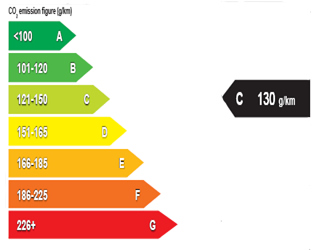
The combined figure for fuel consumption is a weighted average of the urban and extra-urban (rural) results. These figures are based on a stationary rolling-road test in warm air, and ignore many real-world factors such as cold starts, short trips, motorway driving and aerodynamics. There are also reports that the car manufacturers are tailoring their cars to do well under the test procedures. However, accurate testing under reproducible real conditions is not easy, and better measures are not readily available. The consumer magazine Which? tests many models, again on a rolling road, but adds cold-start and motorway tests to get somewhat more realistic figures. Virtually everyone finds that the actual consumption they achieve is worse than the official combined figure. Although not at all a scientific survey, you can get some idea of what people actually achieve here. Some models get closer to the official figure than others and painfully few achieve the claimed figures, but your fuel consumption also depends on the type of driving you do and your driving style – we give some fuel-saving tips here. Figures for CO2 emissions are closely related to the fuel consumption measurements, and therefore also tend to be optimistic. The emissions figures directly affect the road tax payable – this is shown in the table at the end. New cars on sale have emissions labels, as in the picture. * The official figures provide an approximate, usually optimistic, guide to the relative efficiency of different cars. Why should I choose a small, light car? The energy needed to achieve a given performance is greatly affected by the weight of the car. That is why small cars tend to have the best fuel consumption. Weight can also be reduced by using lighter materials such as aluminium or plastic in place of steel, but the lighter material is often more expensive than steel and often takes more energy to produce. The benefits of lighter weight should show up in the official consumption figures. 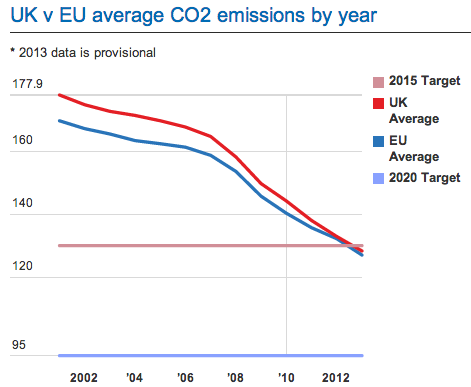
* For environmental reasons you should choose the lightest vehicle that will meet your needs. Fuel efficiency is improving The average fuel efficiency of cars is improving to meet EU targets for the overall average from each manufacturer. The graph shows the year-by-year reduction in CO2 emissions of new cars, and the targets for 2015 and 2020. The original target of 120 g/km for 2015 was relaxed to 130 g/km – this higher value was already achieved in 2013, so the target should probably not have been changed. The main reasons for the improvement have been the very high cost of petrol and diesel, and the availability of much more fuel-efficient engines (both petrol and diesel). But note that the target is an average, and big, thirsty cars are still widely available. Current trends Fully electric cars are on sale but are not yet practical for most people's general-purpose use, so all the viable options still use fossil fuels. This means that much of the discussion is really about more efficient use of fuel – greener rather than green motoring. There are more ‘conventional’ hybrids like the existing Toyota Prius. Some aim for the lowest possible fuel consumption, while larger models try to make luxurious 4x4s and people carriers more acceptable. Plug-in hybrids with batteries that can be recharged from the mains are also available, but at higher prices. What seems less likely is a variety of diesel hybrids. Hybrids are increasingly able to go short distances on batteries alone (useful for commuting or shopping) – some of these are for general-purpose use, while others are really electric ‘city’ cars with low-powered ‘range-extending’ internal combustion engines to reach your destination when the batteries run out. The rapidly increasing number of fully electric models on sale ranges from small city cars to full-size family cars. However, until the problems of limited range, insufficient infrastructure for recharging and long recharging times are dealt with, they are only practical as second cars or for limited use such as relatively short commuting. Major progress with both hybrids and electrics depends crucially on improving battery storage capacity, cost and lifetime, as well as developing infrastructure for recharging and/or quickly exchanging batteries. A key issue is how the electricity for charging the batteries is produced – fossil fuels or renewables – and how the electricity grid will deal with the increased load. Hydrogen-powered cars, either burning hydrogen directly or more likely using fuel cells to generate electricity, have been much touted in the recent past but seem to be much further off, and there are questions about how green the process for obtaining the hydrogen is – see our hydrogen page. We consider other fuel possibilities on our alternative road fuels page. Petrol, diesel, hybrid, electric and alternative fuel summary Petrol cars are the cheapest, and recently developed small petrol engines often have greatly improved efficiency that narrows the gap with diesels. Especially if you don’t drive much and tend to make short journeys, a small petrol car can be a sensible option. There is more information on petrol cars below. Diesel cars typically achieve 30–40% more miles per gallon than petrol ones. The environmental benefit is not quite as big as that because diesel produces somewhat more CO2 per litre, but it is still significant. Diesels are more expensive to buy than equivalent petrol-engined cars, and diesel fuel costs a bit more than petrol, but especially if you cover a lot of mileage the differences are almost certain to be repaid in lower fuel bills over the life of the car, as well as possibly higher resale value. There is more information on diesel cars below, including comments on air pollution, notably due to oxides of nitrogen. Hybrid cars have both petrol and electric engines, and store energy in batteries. Their ability to run the petrol engine at its optimal speed, and the use of regenerative braking, achieves significant improvements in consumption, typically allowing petrol hybrids to rival the emissions of diesels. ‘Plug-in’ hybrids do better for short trips because they can be driven using only electricity, and their batteries can be recharged using mains electricity. However, hybrids are complex and more expensive to manufacture, so it is less likely that the extra cost will be repaid in reduced fuel bills over the life of the car. There is more information on hybrid cars below. Electric cars suffer because they require heavy batteries. At present it is difficult to provide a viable electric car with a range of more than 100–150 miles, there is little infrastructure for recharging, and the required batteries make them very expensive. They are most beneficial for city use, where the lack of exhaust fumes is a significant advantage. The running cost is much less than for a conventional car, and even at present the CO2 generated at the power station is less than from a conventional motor – but ideally the electricity used should be generated from renewable, low-carbon sources. The long time needed to recharge the batteries is a serious disadvantage. There is more information on electric cars below. Alternative fuel cars such as LPG usually require modification of a standard car, with the replacement fuel tank taking up space in the boot. Maintenance and servicing can be problematic. They are not currently sensible options for most users, but we describe future options for other fuels in more detail elsewhere. * Because of their cost, charging problems and limited range, it is unlikely that pure electric cars will be a realistic general-purpose option for most people for at least several years. * Overall, the first choice on environmental grounds (especially in rural areas) is currently an efficient diesel-engined car, provided it really complies with pollution regulations. Is an ‘eco’ version of a car a sensible option? 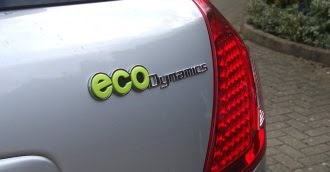
Whether ‘eco’ versions are really better depends on what has been done to improve consumption and emission figures. Some eco models are indeed worthwhile, but for others the fuel consumption is only slightly better. There are often sacrifices, such as no air-conditioning, tyres with lower rolling resistance but worse road holding, and sparse equipment to save weight. There is usually a higher price, which may or may not be justified. Some ‘eco’ features are now available on otherwise conventional cars, such as stop-start systems. And some manufacturers, for example BMW, prefer to introduce improvements to as much as their model range as possible rather than limit them to special ‘eco’ models. * An ‘eco’ version may be a sensible purchase, but compare specifications and pricing with other models carefully. Automatic or manual gearbox? Most automatics use a fluid torque converter, which wastes power and so uses more fuel than the equivalent manual model. Some recent designs are basically manual gearboxes with electronically controlled clutches, and consumption figures can be closer to manual versions. However, realistic comparisons between manual and automatic versions of the same model are not generally available. The ‘official’ consumption figures are based on the limited testing mentioned above, and members of the Initiative have a subjective impression that they tend to be even more optimistic for automatics than for manuals. A good driver of a manual car can achieve better consumption than a driver with an automatic because they can anticipate upcoming conditions, but the discrepancy is sometimes very small. * Provided the automatic version does not involve a significant penalty in consumption figures, the choice can be a matter of personal taste. Energy saving features A variety of technical features can be used to save fuel. Some of the most significant are:
* The user need not be much concerned about how higher efficiency is achieved, and can just consider the overall performance figures. * A stop-start system is advantageous if your journeys involve many traffic lights and/or heavy congestion. Choosing Between Currently Available Models Petrol: Why not just choose a small, frugal petrol car? Petrol-driven cars are the least expensive to buy. Look for overall fuel consumption above, say, 50 miles per gallon. Current designs struggle to do much better than that, although advances in technology such as sophisticated valve control (e.g. Fiat MultiAir) or small engines with supercharging and turbo-charging (e.g. Volkswagen group) have provided some improvement. Petrol engines are much more efficient than they used to be, and petrol also emits less pollution (notably nitrogen oxides) than diesel, although new, tougher standards are narrowing the gap. * Especially if you don’t drive much, a small, efficient petrol car might be the best choice. 
Diesel: Is it better than petrol or a hybrid? Diesel-powered cars have been popular for a long time in countries that have lower taxes on diesel fuel than petrol, such as France, Spain and Italy. In the UK diesel has tended to cost somewhat more than petrol (graph), and diesel cars are also more expensive to buy. The recent popularity of diesels, which now have over 50% of the market, is due to much lower fuel consumption (which also leads to lower annual road tax). Although recycled cooking oil has been promoted as a greener alternative to normal diesel fuel, the car manufacturers say that modern high-tech diesel engines can’t use it – and doing so would nullify any warranty cover. Pros
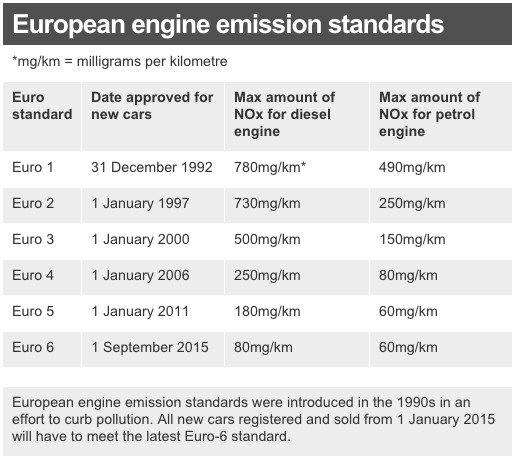
Cons
In Europe, the lower fuel consumption and CO2 emissions of diesel cars have made them very popular, even in the UK where diesel fuel costs a bit more than petrol. However, diesels are often criticised for emitting far more nitrogen oxides in their exhaust than petrol vehicles. Nitrogen oxides (NOx) in the air cause serious respiratory problems and are a major form of air pollution, especially in towns and cities. The biggest emitters of NOx are diesel lorries, buses, vans and cars. However, recent European regulations have required a huge reduction in NOx emissions from diesel engines in cars, as shown in the table. The latest Euro 6 standard, in force for all new cars sold since January 2015, means that diesels must now be nearly equivalent to petrol cars. For both petrol and diesel, this is a huge reduction compared to 15 years ago. * At present, small cars with efficient and recent diesel engines are probably the best option for non-urban driving, provided they really comply with Euro 6. In autumn 2015 it emerged that Volkswagen had equipped 11 million ‘Euro 5 compliant’ diesel cars of all its brands (VW, Audi, Seat, Skoda) with software and hardware that was rigged to pass the NOx tests – but in the real world emitted as much as 10 times more NOx than allowed. VW claims that its current Euro 6 diesels comply. However, tests of both VW and other makes in the ‘real world’ indicate that only a tiny minority of diesel models actually satisfy the standards, due to the very unrealistic European testing regime. The discrepancies are vastly worse than for fuel consumption or CO2 emissions. Click here for an article (pdf) by a member of the Energy Initiative that goes into the VW scandal in more depth. Hybrid: Is a petrol-electric hybrid better than a good diesel? Currently available hybrids have both an electric motor and a petrol engine. At present, battery capacity is limited by the high cost of the most efficient types of batteries and by the weight of large battery arrays. The batteries also reduce the available luggage space in some models, sometimes quite drastically. Some hybrids, for example Honda hybrids (no longer sold in the UK), have the electric motor and petrol engine driving the wheels together. This ‘parallel’ arrangement (first diagram below) allows the petrol engine to be smaller, but these cars cannot run on electric power alone for short journeys. A different arrangement is for the petrol engine to run a generator that powers an electric motor, which in turn drives the wheels. This ‘series’ configuration (second diagram) allows the petrol engine to run at maximum efficiency but tends to have limited power. An example is the Vauxhall Ampera (no longer sold in the UK). Possibly the best current system, called ‘series/parallel’ (third diagram), combines these by allowing the electric motor to drive the wheels on its own at low speed when there is enough charge in the batteries, but switches to the petrol engine at higher speeds and on longer journeys. The two can also work together to give more power when needed, for example going up hills. This system is used in Toyota and Lexus models, including the iconic Toyota Prius. Most hybrid models currently available cannot be recharged using mains electricity, but some recent models can be – see plug-in hybrids, below. Plug-in hybrids tend to have larger battery packs, making them heavier and more expensive. However, some of the extra cost of a plug-in hybrid may be paid for with a government grant (see below). 
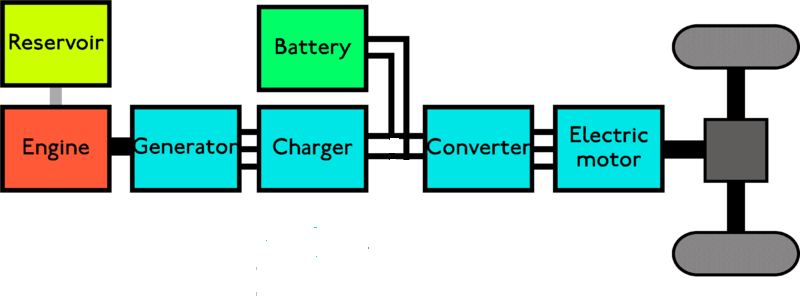
 Pros
Cons
* Petrol-electric hybrids are competitive with efficient diesels and produce somewhat less pollution. They are a good choice especially if you do a lot of urban driving; their advantages are less clear-cut in rural areas. A number of hybrid models with mains-rechargeable batteries are appearing, for example, the Toyota Prius and the Volkswagen Golf GTE. More and better batteries provide an electric-only driving range of about 30 miles at the expense of some boot space and a much higher purchase price. Some plug-in hybrids put more emphasis on the electric side, and are advertised as ‘extended range electric vehicles’. They can all do short journeys, e.g. shopping or commuting, and in some cases longer trips, on their batteries alone without using any fossil fuel. However, because they also have an internal combustion engine they can handle much longer journeys even if the batteries run out unexpectedly, unlike electric cars. This avoids the electric-car problems of ‘range anxiety’, long charging times and non-existent charging infrastructure in mid-journey. However, as with existing hybrids, there are problems fitting in all the required gear and a large battery pack while providing adequate passenger and luggage space. Models range from the Vauxhall Ampera (photo; it's no longer on sale in the UK), which is aimed to be a general-purpose family-size car that can go 30–40 miles on batteries alone before a 1.4 litre petrol engine takes over, to the smaller BMW i3 city car, which is not meant to be used as long-distance cruiser. In fact, the i3 comes in two forms: a fully electric model, and a similar but somewhat dearer version which adds a very small petrol engine that can keep the batteries charged if they are running out. Purchase prices for plug-in models are higher than conventional hybrids due to the need for higher capacity batteries, but the running cost is much lower if electricity is used most of the time. Plug-in hybrids are eligible for the government electric-car subsidy discussed below, which helps offset their higher cost. Recharging from the mains reduces carbon emissions compared to existing hybrids, but it is important to have renewable electricity for this to be a really green solution. The official fuel-consumption figures are almost meaningless for indicating what you might expect from a plug-in hybrid because real-world consumption is critically dependent on how much of the time they are used for short journeys using stored-up mains electricity. For example, when the consumer magazine Which? tested the Volvo V60 Plug-in Hybrid, using tests similar to the official ones but with added motorway and cold-start simulations, they got a combined consumption of 80.7 mpg while the official tests gave 155.2 mpg. For the original Toyota Prius Plug-in they got 78.5 mpg while the official figure is 134.5 mpg. Both cars did worst in the motorway part of the Which? tests, only achieving 40-odd mpg, and the Vauxhall Ampera was similar. * Plug-in hybrids may prove to be a very good option if most of your journeys are short and can be done in electric mode. Why aren’t there more hybrids with diesel engines and/or manual gearboxes? There are several reasons. The US market, which is a main one for manufacturers such as Toyota and Honda, demands automatics. Diesels don’t sell well in the US due to a combination of some very bad diesels in the distant past, and pollution regulations concerning soot and nitrogen oxides. (The main suppliers of the few diesel cars in the US are Volkswagen/Audi and Mercedes – the recent VW diesel emissions scandal will also reduce diesel sales in the US.) In addition, hybrid technology is expensive and diesels would make it even more so. Toyota claims that the automatic gearbox is needed for smoothness when mixing petrol and electric power in their series/parallel arrangement. On the other hand, Honda (which uses the rather different parallel hybrid layout) offered the CR-Z hybrid sports car with a manual gearbox (it is no longer sold in the UK). There are beginning to be diesel hybrids from European manufacturers. Peugeot (which is not dependent on the US market) now offers the Peugeot 3008 and Citroën DS5 Hybrid4 models, and Volvo has the V60 Plug-in Hybrid. The configuration of these three is unusual: a normal diesel engine drives the front wheels, and an electric motor drives the rear wheels. The car can run in diesel-only front-wheel drive, electric-only rear-wheel drive with zero emissions but a range of only a few miles, and a combined four-wheel-drive mode. The Mercedes-Benz E300 diesel hybrid has a diesel engine combined with a fairly small electric motor. The motor assists the diesel engine when the car is accelerating and is reversed for the recuperation of braking energy in alternator mode, although it is also suitable for driving a few miles using electric power alone. Diesel-electric hybrid buses (e.g. Dennis and Volvo) are now being used in the UK in large numbers (in London, Reading and Oxford among others). Electric: are the current and soon-to-appear models a good solution? Sales of electric cars have taken off much more slowly than hoped for. The next few paragraphs mention the main reasons. Prices of electric cars are very high, though somewhat reduced by a government grant. However, running costs are much lower using mains electricity compared to petrol or diesel, especially if you can recharge on a lower, night-time electricity tariff or on sunny days using solar panels. But a big uncertainty is what their second-hand resale values will be; we will not know that for several years. Batteries are the biggest problem for electric cars (and plug-in hybrids). Energy is stored in existing types of batteries at a much lower density than in petrol or diesel fuel. This means that big, heavy, and very expensive battery packs are needed. The weight limits performance, the size makes providing sufficient space for passengers and luggage difficult, and the relatively small amount of stored energy limits the range – this is the most serious problem. Progress is being made, but much more research and development is needed and it is a difficult and slow process – short driving ranges and long recharging times speak for themselves. The currently favoured battery type, lithium-ion, has to be very carefully made and recharged. If faulty or not treated carefully they can overheat and even start a fire. (This has been a problem with some laptop computer batteries, and on Boeing Dreamliner planes.) A serious concern for people buying electric cars is how long the batteries will last and the high cost of replacing them. One solution being offered by some manufacturers is not to include the cost of the batteries in the price of the car, but rather to lease them by the month. Parking spaces with charging points to recharge depleted batteries, mainly in towns and cities, will help, but general coverage of the country will take a long time and progress has been much slower than planned. It’s a chicken and egg situation: few charging points means people won’t buy electric cars, and as a result the existing charging points are little used so there is no feeling of urgency to install more very quickly. 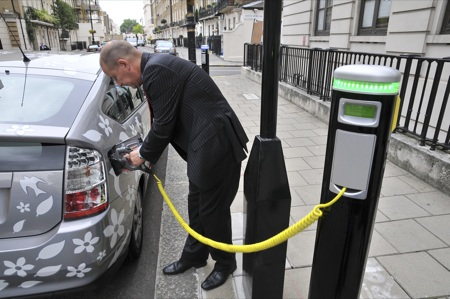
Charging time is also a serious problem. On long journeys even a ‘quick’ half-hour recharge at a charging station (photo) takes too long. For recharging at home, special high-current boxes can speed up charging so that a full charge takes several hours, which otherwise takes even longer using a normal mains socket. (There are government grants for installing special charging boxes at home, the Electric Vehicle Homecharge Scheme.) A possible solution, if batteries are sufficiently standardised and on lease, is for ‘filling’ stations that can do a quick swap of discharged batteries for fully charged ones. A scheme to do this for one particular model, the Renault Fluence, was tried in Israel but has failed. Electricity supplies need considering if electric cars are to be widely used. If all the cars on UK roads were electric, and if they were to recharge their batteries using the present mains electricity mix (which is mostly generated using fossil fuel), their improved efficiency would reduce carbon emissions by something like 50% compared to petrol and diesel vehicles. That would help, but we need clean, renewable electricity to do better. Another problem is that shifting the energy source of all UK cars onto the electricity network is estimated to require something like 16% more electricity generating capacity, or around 10 gigawatts. However, rather than build more capacity, much of the increase could be absorbed by a smart grid combined with smart chargers that, whenever possible, work when the grid load is low (especially during the night) and thus require little new peak generating capacity. As a by-product, this could help in dealing with the intermittent nature of some renewable energy sources, such as wind and solar. Electric car design must be different from fossil-fuel cars. For example, heating the car in winter or running air conditioning in summer can rapidly drain the batteries, so unlike cars at present there needs to be excellent thermal insulation and ventilation. The electric motors in these cars are small, relatively simple, and do not need a complex gearbox, but a large battery pack is required. Will the batteries be standardised, or will the motor industry emulate on a large scale the situation with many electronic gadgets and use batteries specific to each different model? Is the current, fairly conventional layout of front-engine, mostly front-wheel drive still the best? * Lighter, cheaper batteries that hold much more charge, and which can be recharged more quickly, are essential – the improvement needed in both capacity and charging time is a factor of at least four or five. The grants scheme for buyers of fully electric cars and plug-in hybrids provides a 35% discount up to a maximum of £4500 in order to stimulate sales of these cars, which tend to be very expensive for what they offer. Vans are also covered, with a discount of 20% up to a maximum of £8000. The grant was initially flat, but now depends on the car’s range and CO2 emissions. There are four categories:
You canít get a grant for second-hand vehicles, or category 2 or 3 vehicles with a recommended retail price of £60,000 and over. The list of cars covered at present, and their categories, is available here. 
Fully electric examples Many manufacturers have been developing fully electric models, and it is not always easy to tell which ones are actually going to be on sale and which are just research projects. Here is a small selection of models now available, chosen to illustrate the variety of the designs – no attempt is made to list all the models on sale. Nissan Leaf The Nissan Leaf (‘Leading, Environmentally Friendly, Affordable, Family Car’, photo at right) is a family-sized 5-door hatchback. It went on sale in 2011 and is now built in the UK. The nominal range is now over 100 miles, though this varies greatly with driving conditions, terrain and weather. The cars have two charging connectors – a normal household connection, which takes about 10 hours for a full recharge, and a special high-current connector for a quicker recharge, e.g. to about 80% of capacity in half an hour. The battery can either be on lease or included with purchase of the car.
Peugeot iOn and Citroën C-Zero The car is shown in the diagram; note how different the layout is compared to a conventional car. It is a small city car with four doors and four seats. Like the Leaf, its range is a nominal 100 miles and it has both a normal, slow-charging mode and a quick, half-hour mode to get to 80% using a high-current three-phase supply.
BMW i3 The BMW i3 (photo at right) is another car designed mainly for city use. It is a hatchback with a range of 80–100 miles. Unusually, a somewhat more expensive ‘range extender’ version is also offered; although that version is technically a plug-in hybrid it is very much more like an electric car with a very small, 2-cylinder petrol engine and a 9-litre fuel tank that is just capable of keeping the battery charged until you reach the destination. Tesla Model S At the other end of the spectrum, there is one electric car that has a substantially longer range than those already listed. The Tesla Model S is a luxurious, powerful car that has a nominal range of either 240 miles or 310 miles depending on which battery pack is installed. For the UK, this model will be available from March 2014 in the 240-mile version; it will cost more than £50,000 (after the government grant). * Some of the available and forthcoming electric models may prove to be a viable but expensive option for short journeys, but in order to be a good general-purpose choice the technology and infrastructure will have to improve by a large factor.
Road tax penalises inefficient cars and rewards greener ones. For cars registered since March 2001 the rate depends on carbon dioxide emissions. Below are the 12-month rates for petrol and diesel cars; 6-month rates and cars using other fuels can be found elsewhere. However, due to a large fraction of new cars now qualifying for low tax rates, the system will be drastically changed for cars first registered from April 2017. Taxes will go up, with the penalties for high-emission vehiclesmore severe for the first year of registration. However, for cars more than one year old only zero-emission cars will be rewarded; others will revert to a tax that does not depend on emissions at all. Note that tax discs (photo at right) are no longer needed or used – anyone checking only needs your plate number to find out if you have paid your tax. Also beware that if you buy a car with time remaining on the tax, changing owners cancels that and you must pay from the date you become the new owner. Cars registered before 1 March 2001 (based on engine size) Up to 1549 cc: £145 Over 1549 cc: £235 Cars registered from 1 March 2001 to 31 March 2017 (based on CO2 emissions) Below are the tax rates for the year from April 2016 to March 2017. Owners of cars emitting 120 g/km or less are significantly rewarded; the tax increases rapidly from there as emissions rise. To further reward green cars and penalise inefficient ones, the tax for many new cars is different in their first year – this is shown in the last column. New cars emitting up to 130 g/km pay no tax the first year, but new cars emitting more than 165 g/km are penalised further in order to discourage people from buying them. Pure battery electric cars pay no tax. Hybrids and LPG cars get an extra £10 discount in all bands, for both the first and subsequent years.
* Cars that were registered before 23 March 2006 and have a CO2 figure over 225 g/km are all included in Band K. Cars registered from 1 April 2017 The following was proposed in the 2016 budget, but may not be certain. The first year after registration will reward low-emission cars, but after that only zero-emission (i.e. pure electric) cars are rewarded. In addition, for the first five years cars with a list price when new of more than £40,000 pay an additional £310 per year.
|
 |
If you have any comments or queries about this website please contact the
webmaster. |
© Blewbury Energy Initiative 2016 |